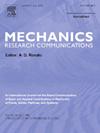Effect of shape and interpenetration of ellipsoidal pores on effective physical properties of closed-cell porous materials
IF 2.3
4区 工程技术
Q3 MECHANICS
引用次数: 0
Abstract
The purpose of this study is to clarify the effects of pore shape and interpenetration on the effective elastic modulus and thermal conductivity of closed-cell porous materials. For this purpose, the theoretical solutions for these effective physical properties of a model with ellipsoidal pores oriented randomly in the matrix are derived based on some homogenization methods such as the differential scheme (DS). The obtained solutions are expressed uniformly in terms of the geometrical factors given only by the aspect ratio of ellipsoidal pores. In addition, a model in which ellipsoidal pores are not only oriented randomly in the material but also interpenetrating is generated using the regular polyhedron orientation method associated with the golden ratio. Finite element method (FEM) analyses of this model are also performed. The effective physical properties of various closed-cell porous materials are calculated by the theoretical solutions and FEM. These results are compared with the experimental ones. When spherical pores do not interpenetrate, the DS results for effective physical properties show good agreement with the experimental and FEM results. However, when spherical pores interpenetrate, the DS results tend to be slightly higher than these results. This difference becomes negligible when the pore volume fraction is less than 0.5. Moreover, when the pore shape is non-spherical, such as elongated or flattened, the effect of interpenetration is reduced. As a result, the DS results show good quantitative agreement with the FEM results. These findings demonstrate that the DS can evaluate the effective physical properties of porous materials with a certain degree of accuracy, regardless of the shape and interpenetration of pores. The effective Young’s modulus and thermal conductivity tend to be highest when the pore shape is spherical and decrease as the pore shape becomes flatter. As an application of these findings, we present design guidelines for hybrid porous materials that improve insulation while maintaining stiffness.
椭圆孔的形状和相互渗透对闭孔多孔材料有效物性的影响
本研究的目的是阐明孔隙形状和相互渗透对闭孔多孔材料有效弹性模量和导热系数的影响。为此,基于微分格式(DS)等均质化方法,推导了椭球状孔隙在基体中随机取向模型的这些有效物理性质的理论解。所得的解统一地表示为仅由椭球孔长径比给出的几何因子。此外,利用黄金分割的正多面体定向方法,生成了椭球状孔隙在材料中随机定向且相互贯通的模型。并对该模型进行了有限元分析。采用理论解和有限元方法计算了各种闭孔多孔材料的有效物理性能。所得结果与实验结果进行了比较。当球形孔隙不互渗时,有效物性的DS计算结果与实验和有限元计算结果吻合较好。然而,当球形孔隙相互渗透时,DS结果往往略高于这些结果。当孔隙体积分数小于0.5时,这种差异可以忽略不计。此外,当孔隙形状为非球形时,如拉长或扁平时,相互渗透的影响减弱。结果表明,数值模拟结果与有限元计算结果吻合较好。这些结果表明,在不考虑孔隙形状和相互渗透的情况下,DS能够以一定的精度评价多孔材料的有效物理性质。孔隙形状为球形时,有效杨氏模量和导热系数最高,孔隙形状越扁平,有效杨氏模量和导热系数越低。作为这些发现的应用,我们提出了混合多孔材料的设计指南,以提高绝缘,同时保持刚度。
本文章由计算机程序翻译,如有差异,请以英文原文为准。
求助全文
约1分钟内获得全文
求助全文
来源期刊
CiteScore
4.10
自引率
4.20%
发文量
114
审稿时长
9 months
期刊介绍:
Mechanics Research Communications publishes, as rapidly as possible, peer-reviewed manuscripts of high standards but restricted length. It aims to provide:
• a fast means of communication
• an exchange of ideas among workers in mechanics
• an effective method of bringing new results quickly to the public
• an informal vehicle for the discussion
• of ideas that may still be in the formative stages
The field of Mechanics will be understood to encompass the behavior of continua, fluids, solids, particles and their mixtures. Submissions must contain a strong, novel contribution to the field of mechanics, and ideally should be focused on current issues in the field involving theoretical, experimental and/or applied research, preferably within the broad expertise encompassed by the Board of Associate Editors. Deviations from these areas should be discussed in advance with the Editor-in-Chief.

 求助内容:
求助内容: 应助结果提醒方式:
应助结果提醒方式:


